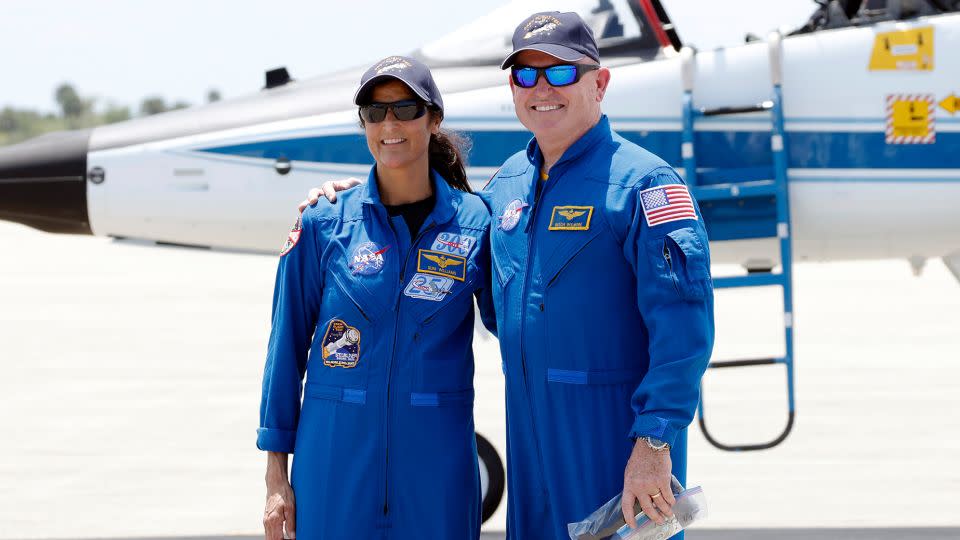Sign up for CNN’s Wonder Theory science newsletter. Explore the universe with news on fascinating discoveries, scientific advancements and more.
Two NASA astronauts have reached the final hours before a long-awaited launch attempt aboard Boeing’s Starliner capsule, marking the first crewed mission of the brand-new spacecraft.
Starliner — which the aerospace giant designed to rival SpaceX’s prolific Crew Dragon capsule — is set to take off for its inaugural crewed test run at 10:34 p.m. ET Monday from Cape Canaveral Space Force Station in Florida.
NASA will webcast the event on its channels beginning at 6:30 p.m. ET Monday. CNN will carry live updates of the mission online shortly before liftoff.
Weather or technical issues can always force a rocket launch to scrub all the way up until the countdown clock strikes zero, but the forecast for this evening is as good as it gets. Weather officials have said there’s only a 5% chance that clouds, winds or storms will interrupt tonight’s takeoff.
This mission, dubbed the Crew Flight Test, could be the final major milestone before NASA deems Boeing’s spacecraft ready for routine operations as part of the federal agency’s Commercial Crew Program. The Starliner would join SpaceX’s Crew Dragon in NASA’s push to collaborate with private industry partners, expanding the United States’ options for ferrying astronauts to the International Space Station.
The mission crew members are veteran astronauts Suni Williams and Butch Wilmore, each of whom has ventured to space on two previous journeys aboard NASA space shuttle and Russian Soyuz missions.

“They’re checking out a lot of the systems: the life support, the manual control,” NASA Administrator Bill Nelson said during a Friday news conference. “That’s why we put two test pilots on board — and of course the résumés of Butch and Suni are extensive.”
This would mark only the sixth maiden voyage of a crewed spacecraft in US history, Nelson noted: “It started with Mercury, then with Gemini, then with Apollo, the space shuttle, then (SpaceX’s) Dragon — and now Starliner.”
Williams will also become the first woman ever to join such a mission.
What to expect
If all goes to plan, the crew will board the Starliner capsule and lift off atop an Atlas V rocket Monday night. The spacecraft — carrying the astronauts — will break away from the rocket after reaching orbit and begin firing its own engines. The Starliner will then spend more than 24 hours gradually making its way to the space station, where the vehicle is expected to dock at 12:46 a.m. ET Wednesday.
Williams and Wilmore are set to spend about a week aboard the orbiting laboratory, joining the seven astronauts and cosmonauts already on board, while the Starliner remains docked outside.
The two will then return home aboard the same Starliner capsule, which is expected to parachute to a landing at one of several designated locations across the southwestern United States.
Boeing vs. SpaceX
Much is riding on a smooth test flight. NASA has been waiting half a decade for Starliner to begin flying crew, and the development of Starliner was beset by years of delays, setbacks and blunders. More broadly, Boeing as a company has suffered years of scandals in its aircraft division that have tarnished the legacy aerospace giant’s brand.
“We got through a pretty rigorous process to get here,” said Mark Nappi, vice president and Starliner program manager at Boeing, of the development process during the Friday briefing. “And really where my source of confidence comes from is going through that process.”
If successful, the Crew Test Flight could queue up Boeing to begin flying routine trips to the space station on NASA’s behalf.
The US space agency selected Boeing to develop Starliner — alongside SpaceX and its Crew Dragon capsule — in 2014, hoping the commercial companies could create complementary new means of ferrying astronauts to the International Space Station after the space shuttle program retired in 2011.
SpaceX ultimately beat Boeing to the launchpad, carrying out its crewed flight test of the Crew Dragon capsule in May 2020. SpaceX has handled most of NASA’s crew transportation needs since then.
“We cheer for SpaceX. That’s something that is very important to our country and very important to NASA to have that access.” Nappi said during a March news briefing. “And we’re looking forward to providing (astronaut transportation services) as well.”
For more CNN news and newsletters create an account at CNN.com
